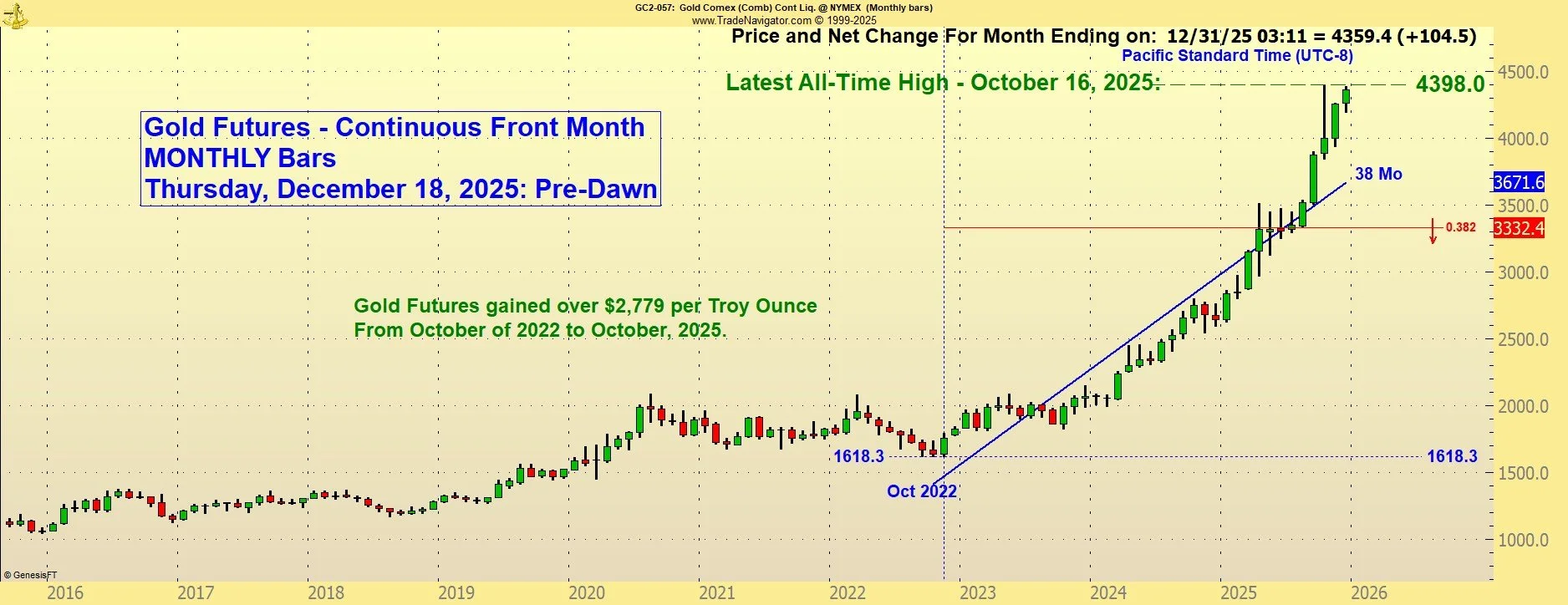GOLD: Daily and Monthly Charts
Comment as of Tuesday, Oct 14, 2025: Pre-Dawn
It is intuitively clear that only central bank-sized money has enough power to lift gold as far and as quickly as it has risen. There is a logic of competition with the U.S. Dollar that appeals to China, India, and Turkey, as well as European countries such as Poland and Hungary. These are the leading nations that have driven gold prices up in their efforts to offset the power of the greenback through gold reserves behind their currencies. The Chinese in particular wish to enhance the international value of the yuan in a long term strategy.
The price of gold has always been most responsive in a high anxiety, uncertain environment. Daily tariff announcements and talk of large-scale, defensive central bank actions have triggered significant buying, including retail transactions. Many individuals in China and India, for example, have been pushing savings into gold as a “safe storage”, but the amount of capital it takes to move gold $2,570 per Troy ounce in 3 years is more than the retail trade has contributed. This kind of upward lift requires central-back-sized blocks of money. The bankers must have calculated that reserves should be at least partly held in precious metals, mostly gold.
The World Gold Council has commented that central banks purchased over 1,000 metric tons of gold in 2024, nearly twice the average gold buying amount for the last 10 years. The most likely culprits are suggested to be Uzbekistan, China, Kazakhstan, Poland, and India.
If the “Tariff Parade” is any kind of success for the Trump Administration, with resolution of challenges emerging between the U.S. and many nations (including China), a market reaction may show up more quickly than many observers expect. This could have the effect of a gold price relaxation downward, part of a “normal” market correction of a period of extreme price increase, with or without obvious reason. Even a common-sized drop of 10%-15% would trim $350-$525 from current prices without disturbing the technical chart uptrend.
There is still large, upward momentum in the gold futures contract. The hyperbolic trendline prevents simple chart tracking. The downside risks are considerable, with very rapid and unpredictable pullbacks, even though “normal” for a market with an intact uptrend, will be large enough to seriously damage a small account.
The amount of capital now tied up in the Comex full-size (100 Troy ounce) gold contract market alone is very large, calculated based on open interest at about 156 billion dollars in nominal contract value, with initial margin requirements of 14 billion dollars including both long and short sides. This market is not for everyone. The long-term upward bias is intact, but has become “mature”. The longer the hyperbolic move continues, the more violent the natural pullback will be (when and not if it comes). It is under this kind of volatile circumstances that exchanges increase margin requirements, sometimes dramatically, to protect the market. The market is redefining the definition of “small” accounts.
Gold Price Factors:
Supply and Demand: Gold supply and demand are affected by mining production increases or declines. Jewelry and other private consumption is a significant factor. Electronics and other industrial demand can lead to price shifts. Gold producers, physical traders and end-users do not speculate, but use the gold futures markets to control the risks of ownership, contracted delivery or receipt obligations.
Investor Sentiment: Either Fear of Missing Out (FOMO) or SOL (Selling on Low) capitulation. Market sentiment and speculator behavior can drive short-term price movements stimulated by events, news and rumors.
Technical Analysis: Technical chart patterns have significant effects on a large number of speculative trade decisions, as the newswires and other opinion sources are often deemed untrustworthy. There is evidence that price movements make the news rather than the news making the price movements, as opinions and confirmation bias are often not based on real-world money decisions, but on public demands for explanations of price movements. Price charts frequently lead the news.
Economic Conditions: The overall state of the global economy; including inflation rates, interest rates, and financial stability all influence gold prices. Gold trends upward in value as a safe-haven asset when trade in other assets becomes difficult.
Geopolitical Events: Political upheaval and instability, military conflicts and trade tensions between nations can significantly impact gold prices, as investors often flock to gold as a safe-haven asset during times of geopolitical turmoil.
Currency Movements: The value of the U.S. dollar has an inverse relationship with gold prices. A weaker dollar typically leads to higher gold prices, as gold becomes more attractive to international investors, who may exit dollars and place their capital in gold when market risks and volatility are high.
Central Bank Policies: The accumulation or distribution of gold by central banking entities can affect prices. Large-scale purchases or sales by central banks can move supply and demand dynamics of the gold market.


